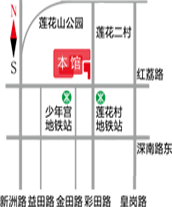
- Shenzhen, this hot land, is worth the sweat of designers
-
Article source: Shenzhen Special Zone Daily, October 11, 2009
At the 11th National Art Exhibition, the transcripts presented by Shenzhen in the art and design exhibition area were enough to amaze the whole country: a total of 468 works were finally nominated for this art and design exhibition, and Shenzhen's works reached 57. Out of 468 works, a total of 89 were nominated for awards, with Shenzhen accounting for 14 of them, with a high award nomination ratio of 15%. Today, the National Art Exhibition and Design Exhibition will officially open at the Guan Shan Yue Art Museum and Hua · Art Museum, and will be reviewed by the public.
Shenzhen was awarded the title of "City of Design" by the United Nations last year, and the designers who have been working on this hot land have repeatedly achieved excellent results. The achievements of Shenzhen's design are not achieved overnight. Looking back at the progress of Shenzhen's design industry over the past thirty years, it is not difficult to find that the soul of design and the urban temperament of Shenzhen complement each other. The development of design continues the spirit of innovation in Shenzhen, and the innovative consciousness of Shenzhen people has helped promote the takeoff of the design industry. The brilliant achievements we see now are just the accumulation and thin development of Shenzhen's design industry's long-term experience.
The invisible hand ignites the spark of stars
Last year, during the large-scale cultural celebration of "Era China" held in the UK, the "Creative China" Contemporary China Design Exhibition opened at the V&A Museum in London and caused a sensation. The exhibition selected three cities to interpret contemporary Chinese design, with Shenzhen occupying a prominent position in the exhibition hall as a "cutting-edge city". That's because in the minds of many people, Shenzhen's graphic design is considered the origin of Chinese design. At the beginning of the establishment of Shenzhen Special Economic Zone, the earliest known market economy was leading the country. And the market is precisely the lifeline for the survival of the design industry.
Looking back at the urban construction history of Shenzhen in the past 30 years, we will find that every social transformation is further expanding the market, and the market economy has given birth to the design industry in Shenzhen. The rapidly developing economy has nurtured a huge demand for design, attracting a large number of designers to come here to seek gold and become "cultural merchants". "Shenzhen's graphic design has always been a leading industry in the country, which is related to the earliest development of Shenzhen's advertising industry. In the 1990s, Shenzhen's decoration was unbeatable nationwide, accounting for half of the country's territory, and interior design also swept across the country. Industrial design is also the same, and the high-tech industry is Shenzhen's pillar industry, and it is also one of Shenzhen's design giants. This plays a very important role in Shenzhen's design going up the stairs and going out. Good products need to have a good image, and good images need to have good creativity, which is the driving force of creation. Shenzhen's jewelry design is also the best in the country, which is closely related to the neighboring Hong Kong market," said interior designer South Korea
Riding the east wind of the market, Shenzhen's design development has been singing along the way. In the past decade, Shenzhen's design industry has gained leading and guiding advantages in China and even Asia. Shenzhen has become a major hub for Asian design and a core city for modern Chinese design, attracting high attention from the international community. Shenzhen's design forces are starting to compete in the global market. Taking graphic design as an example, designers in Shenzhen have almost won awards from all top design competitions and international exhibitions in the world, such as the Shomon Poster Festival in France, the Mexico International Poster Biennale, the Toyama International Poster Exhibition in Japan, and have been selected for all authoritative design publications in the international design industry.
"Shenzhen has great potential. China is an emerging market in the period of construction and development, and now coincides with the transition from a manufacturing country to a creative country. There is a great demand for design, and Shenzhen design can develop rapidly with this trend." Zhang Jianmin, who specializes in Shenzhen subway signage design, told reporters. Fully utilizing social forces and promoting industrial development in a market-oriented manner is a major successful experience in the development of cultural and creative industries in Shenzhen. Under the guidance and promotion of the government, most cultural enterprises in Shenzhen have been market-oriented from the beginning, conducting market-oriented operations. Even large-scale events such as the Cultural and Industrial Fair have entrusted most of their projects to enterprises for specific operations. It can be said that under the careful care of policies and regulations, it is the hands of the market that have lifted today's "design city".
"I returned to China for development from the United States in early 2007. At that time, I also wanted to go to cities like Beijing and Shanghai where design friends are concentrated, but in the end, I chose Shenzhen." Zhang Zhiyang, the architect in charge of a design firm in the bureau, said that the healthy and open environment of Shenzhen's architecture industry is very attractive to him.
This is not the first time a journalist has heard this sentence from a designer. If the promotion effect of social transformation on design is "unintentionally planting willows and willows to create shade", then since the Municipal Party Committee and Government proposed to vigorously develop the creative industry, the policy tilt has made the design industry thrive like spring breeze. Vigorously developing the creative industry is a strategic choice made by Shenzhen after considering its own economic and social development status. In January 2003, the sixth plenary session of the third session of the Shenzhen Municipal Party Committee officially established the implementation of the "cultural city" strategy, proposed the concept of establishing a "cultural economy", and built Shenzhen into a high-quality cultural and ecological city. In 2004, Shenzhen proposed the construction policy of "two cities and one city" to build a "library city", "piano city", and "design city". In the same year, the first International Cultural Industry Expo was held in Shenzhen. The annual cultural and artistic exhibitions have become a carrier for showcasing excellent creative design works.
At the same time, Shenzhen seized the opportunity to propose the goal of building a "city of design" and established the concept that "design is the core competitiveness of the industry", thus paving the way for the great development of Shenzhen's design industry. Industrial design, graphic design, architectural design, clothing design, interior design, game design, and software design have entered a flourishing stage of comprehensive development. In terms of fashion design, Shenzhen women's clothing brands now occupy more than 70% of the national market. Famous designer Luo Zheng took her Opelano to the stage of New York Fashion Week, achieving a breakthrough of zero for Chinese women's clothing brands. And industrial design has also achieved brilliant results. In recent years, the branding development of Shenzhen's industrial design has become a phenomenon of attention in China, such as Artopdesign, NewplanDesign, and Tiyta, the only listed company in the Chinese watch industry. For example, in anime design, a group of ambitious individuals who insist on originality have risen in recent years. High quality works such as "Fuwa", "Confucius", "Mobishuan", "Fengyun", etc. have caused a huge response in China... December 7th of this year was legally designated as "Shenzhen Creative Design Day", and the establishment of this festival has made design not only a discipline, but also a way of life for the whole nation. Today, the goal of building a "city of design" has been achieved, and the design industry has become a true "engine" driving economic growth.
Design talents are pouring in one after another
With the fertile land of the market and the huge nest of policies, designers from all over the country naturally come here as if returning home. Zhang Lichuan, who graduated from the School of Fine Arts at Tsinghua University last year, is one of them. She told reporters that many students studying in Beijing are accustomed to staying in their original places after graduation, and she chose to go south. In less than a year, she obtained an unexpected opportunity: her clothing design work "Midsummer Night's Dream" was nominated for a gold medal at this national art and design exhibition. In her opinion, the biggest advantage of Shenzhen is its proximity to the market. Therefore, many domestic design schools are now setting up branches in Shenzhen, hoping to enable students to quickly enter the market and become competitive after graduation. What impressed her even more was the relaxed policy here: "The people here have great respect for designers, and the public opinion atmosphere of the whole society gives designers a considerable space to showcase themselves."
This year marks the first year that Shenzhen has been honored as the "City of Design" by the United Nations. Shenzhen's design talents have imprinted Shenzhen's mark on the history of Chinese design through practical actions: Shenzhen interior designer Lin Wenge won the championship in the Luxury/Upscale Hotel category of the Hospitality Design Awards in the United States, becoming the only Asian designer to receive the highest honor WINNER Award in this category this year; The designers of Shenzhen Urban Practice Architecture Firm and OMA led by international architect Kuhaas collaborated to design the "urban halo" of Shenzhen Crystal Island, which has caused a huge response internationally; Shenzhen graphic designer Chen Shaohua won the Best Logo Design Award at the 2011 Xi'an International Horticultural Exposition... New design talents have sprung up like mushrooms after rain. Zhao Zhenjie, a college student from Shenzhen, won the Excellent Visual Information Design Award in the National College Student Graphic Design Competition. The nomination for new design talents in this year's National Art and Design Exhibition is on par with well-known designers. A design critic commented, "Shenzhen has become a banner of modern Chinese design and the Paris Montmartre district in the hearts of the new generation of designers."
At present, many of the leading figures and most influential designers in China's design industry are located in Shenzhen, where three-quarters of the country's design talents gather. Shenzhen's design advantages in the country radiate to the whole country through talent mobility. Shenzhen has over 6000 strong design enterprises and over 60000 professional designers, covering more than 10 fields including graphic design, industrial design, architectural design, animation design, and software design. In the most authoritative international designers association (AGI), there are only 6 members in China, including two in Shenzhen. These talented and ambitious designers, taking Shenzhen as their home, strive to create their own world, and they also use their wisdom to open up a picture of Shenzhen that shines with glory and dreams everywhere.



